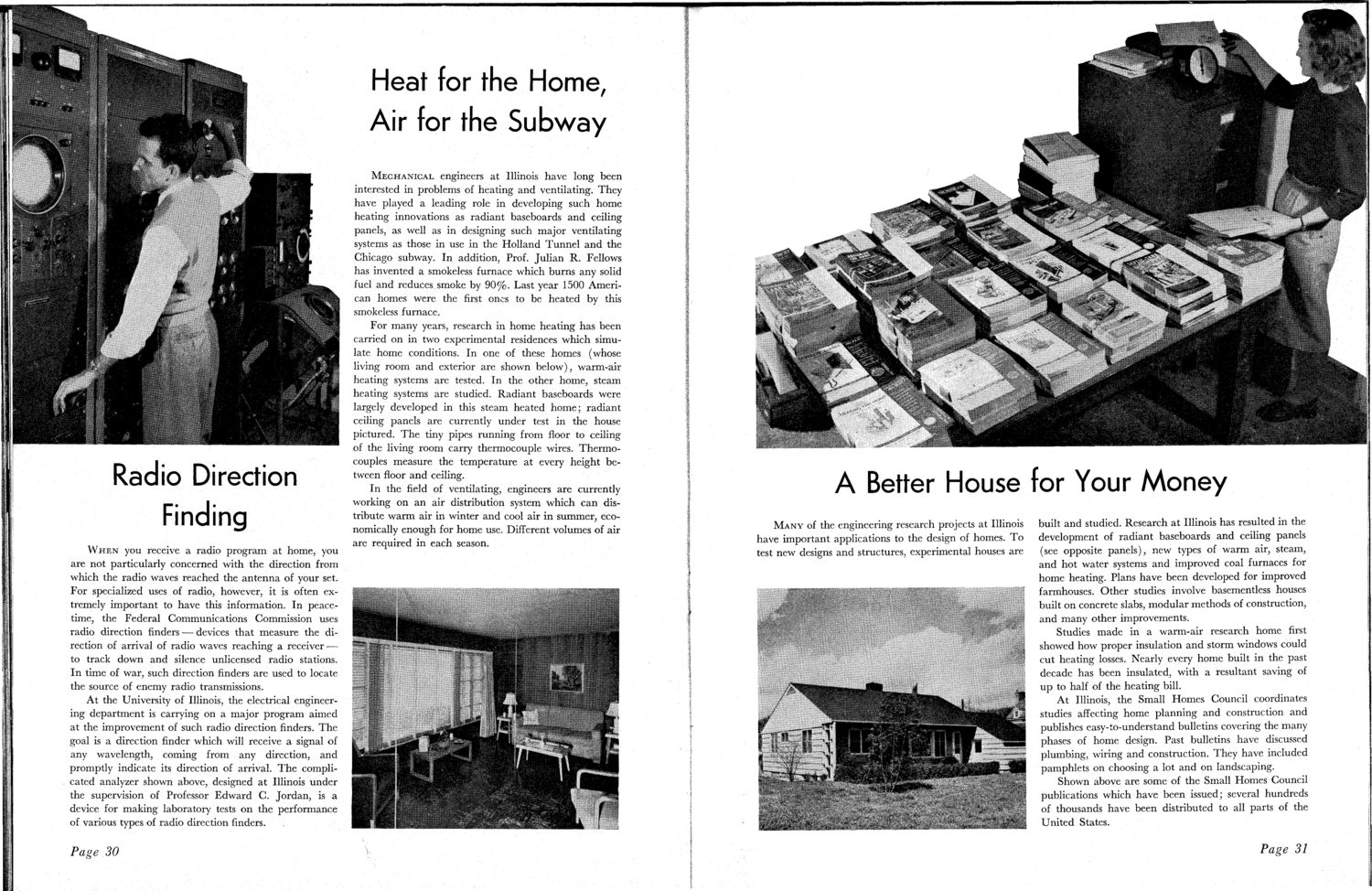| |
| |
Caption: Book - Research on Campus (1949)
This is a reduced-resolution page image for fast online browsing.

EXTRACTED TEXT FROM PAGE:
Heat for the Home, Air for the Subway MECHANICAL engineers at Illinois have long been interested in problems of heating and ventilating. They have played a leading role in developing such home heating innovations as radiant baseboards and ceiling panels, as well as in designing such major ventilating systems as those in use in the Holland Tunnel and the Chicago subway. In addition, Prof. Julian R. Fellows has invented a smokeless furnace which burns any solid fuel and reduces smoke by 9 0 % . Last year 1500 American homes were the first ones to be heated by this smokeless furnace. For many years, research in home heating has been carried on in two experimental residences which simulate home conditions. In one of these homes (whose living room and exterior are shown below), warm-air heating systems are tested. In the other home, steam heating systems are studied. Radiant baseboards were largely developed in this steam heated h o m e ; radiant ceiling panels are currently under test in the house pictured. T h e tiny pipes running from floor to ceiling of the living room carry thermocouple wires. Thermocouples measure the temperature at every height between floor and ceiling. In the field of ventilating, engineers are currently working on an air distribution system which can distribute warm air in winter and cool air in summer, economically enough for home use. Different volumes of air are required in each season. Radio Direction Finding W H E N you receive a radio program at home, you are not particularly concerned with the direction from which the radio waves reached the antenna of your set. For specialized uses of radio, however, it is often extremely important to have this information. In peacetime, the Federal Communications Commission uses radio direction finders — devices that measure the direction of arrival of radio waves reaching a receiver — to track down and silence unlicensed radio stations. I n time of war, such direction finders are used to locate the source of enemy radio transmissions. At the University of Illinois, the electrical engineering department is carrying on a major program aimed at the improvement of such radio direction finders. T h e goal is a direction finder which will receive a signal of any wavelength, coming from any direction, and promptly indicate its direction of arrival. T h e complicated analyzer shown above, designed at Illinois under the supervision of Professor Edward C. Jordan, is a device for making laboratory tests on the performance of various types of radio direction finders. A Better House for Your Money M A N Y of the engineering research projects at Illinois have important applications to the design of homes. T o test new designs and structures, experimental houses are built and studied. Research at Illinois has resulted in the development of radiant baseboards and ceiling panels (see opposite panels), new types of warm air, steam, and hot water systems and improved coal furnaces for home heating. Plans have been developed for improved farmhouses. Other studies involve basementless houses built on concrete slabs, modular methods of construction, and many other improvements. Studies made in a warm-air research home first showed how proper insulation and storm windows could cut heating losses. Nearly every home built in the past decade has been insulated, with a resultant saving of u p to half of the heating bill. At Illinois, the Small Homes Council coordinates studies affecting home planning and construction and publishes easy-to-understand bulletins covering the many phases of home design. Past bulletins have discussed plumbing, wiring and construction. They have included pamphlets on choosing a lot and on landscaping. Shown above are some of the Small Homes Council publications which have been issued; several hundreds of thousands have been distributed to all parts of the United States. Page 30 Page 31
| |